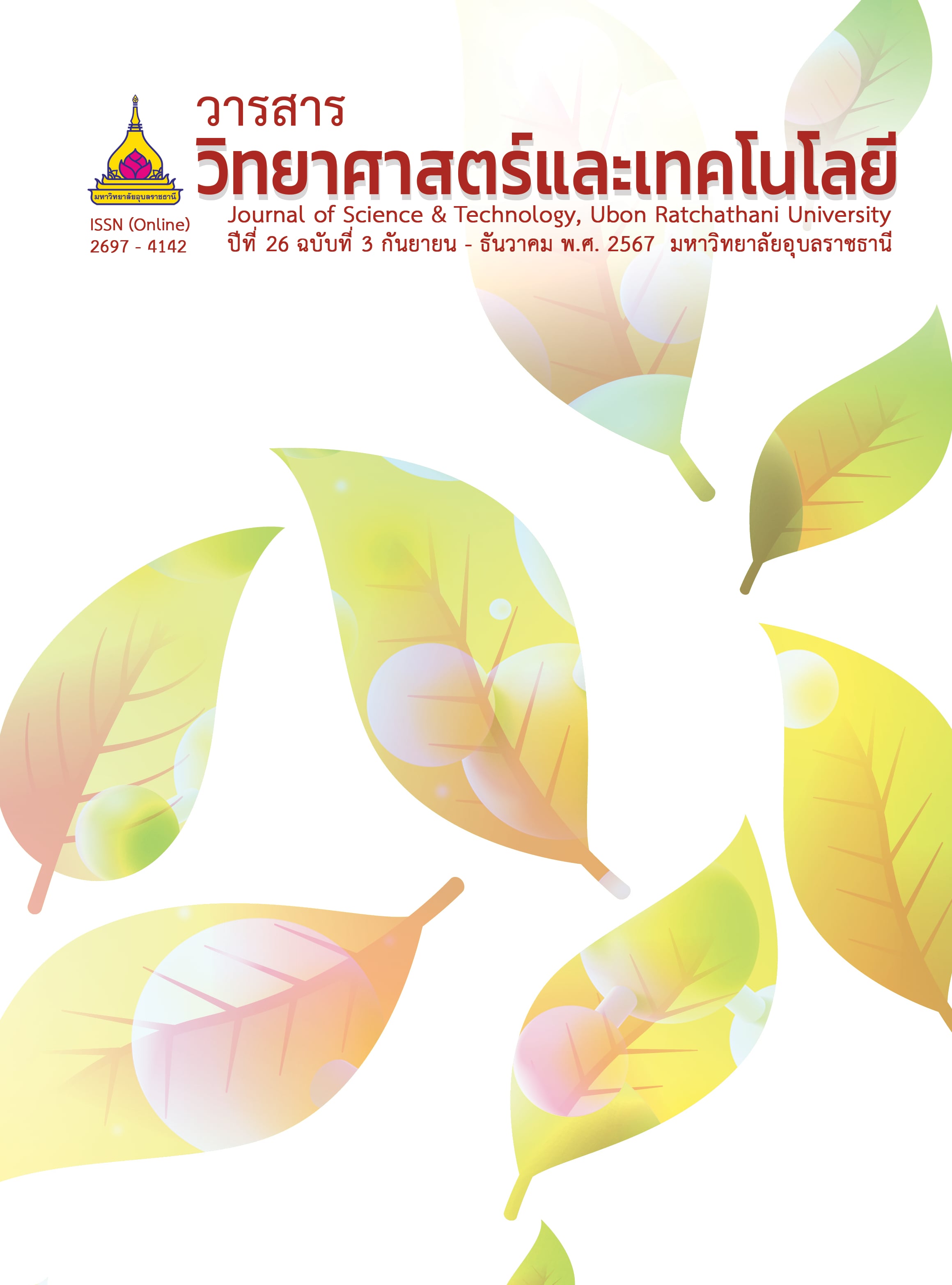ความหลากหลายทางชีวภาพและศักยภาพในการผลิตสารชีวภาพของแอคติโนมัยสีท ที่แยกจากดินในอุทยานประวัติศาสตร์พนมรุ้ง จังหวัดบุรีรัมย์
Main Article Content
บทคัดย่อ
แอคติโนมัยสีทเป็นแบคทีเรียที่มีสมบัติโดดเด่นด้านการผลิตสารชีวภาพที่มีคุณสมบัติหลากหลาย เช่น สารสี สารต้านจุลชีพ และสารต้านอนุมูลอิสระ งานวิจัยนี้มีวัตถุประสงค์ เพื่อแยก คัดเลือก และศึกษาความสามารถในการผลิตสารชีวภาพบางชนิดของแอคติโนมัยสีทจากดินของอุทยานประวัติศาสตร์พนมรุ้ง จังหวัดบุรีรัมย์ แยกแอคติโนมัยสีทด้วยวิธี spread plate บนอาหารที่เหมาะสมต่อการเจริญของแอคติโนมัยสีท ได้แก่ Starch Casein Agar (SCA), International Streptomyces Project 1 (ISP1), Actinomyces Isolation agar (AIA) และ Hickey’s Terner agar (HTA) ศึกษาลักษณะโคโลนีของแอคติโนมัยสีทที่แยกได้เมื่อเลี้ยงบนอาหารแข็ง SCA ภายใต้กล้องจุลทรรศน์แบบสเตอริโอ ทดสอบความสามารถในการหลั่งสารสีออกนอกเซลล์เมื่อเลี้ยงในอาหารเหลว Starch Casein Broth (SCB) ทดสอบฤทธิ์ต้านแบคทีเรียก่อโรค 5 สายพันธุ์ ได้แก่ Escherichia coli TISTR 527, Klebsiella pneumoniae TISTR 1867 Pseudomonas aeruginosa TISTR 2370 Bacillus cereus TISTR 2372 และ Staphylococcus aureus TISTR 746 ด้วยวิธี Agar block method นอกจากนี้ยังศึกษาผลของอุณหภูมิ และแหล่งคาร์บอนในอาหารเลี้ยงเชื้อต่อความสามารถในการผลิตสารสี และสารต้านแบคทีเรียของแอคติโนมัยสีท ผลการศึกษาพบว่าแยกแอคติโนมัยสีทได้ 123 ไอโซเลท จัดกลุ่มเชื้อตามลักษณะสัณฐานวิทยา และตามความสามารถในการผลิตสารต้านแบคทีเรียได้ 8 และ 4 กลุ่ม ตามลำดับ นอกจากนี้ยังพบว่าอุณหภูมิ และแหล่งคาร์บอนในอาหารเลี้ยงเชื้อมีต่อความสามารถในการผลิตสารสี และสารต้านแบคทีเรียของแอคติโนมัยสีท
Article Details

อนุญาตภายใต้เงื่อนไข Creative Commons Attribution-NonCommercial-NoDerivatives 4.0 International License.
บทความที่ได้รับการตีพิมพ์เป็นลิขสิทธิ์ของ วารสารวิทยาศาสตร์และเทคโนโลยี มหาวิทยาลัยอุบลราชธานี
ข้อความที่ปรากฏในบทความแต่ละเรื่องในวารสารวิชาการเล่มนี้เป็นความคิดเห็นส่วนตัวของผู้เขียนแต่ละท่านไม่เกี่ยวข้องกับมหาวิทยาลัยอุบลราชธานี และคณาจารย์ท่านอื่นๆในมหาวิทยาลัยฯ แต่อย่างใด ความรับผิดชอบองค์ประกอบทั้งหมดของบทความแต่ละเรื่องเป็นของผู้เขียนแต่ละท่าน หากมีความผิดพลาดใดๆ ผู้เขียนแต่ละท่านจะรับผิดชอบบทความของตนเองแต่ผู้เดียว
เอกสารอ้างอิง
Donald, L. and et al. 2022. Streptomyces: Still the Biggest Producer of New Natural Secondary Metabolites, a Current Perspective. Microbiology Research. 13: 418-465.
Alam, K. and et al. 2022. Streptomyces: The biofactory of secondary metabolites. Frontiers in Microbiology. 13: 968053.
Hassan, O., Khalil, M.S. and Elnawawy, A.S. 2022. Biodegradation of agricultural wastes by cellulase producing bacteria. International Journal of Innovative Science, Engineering and Technology. 9(1): 2348-7968.
Javed, Z. and et al. 2021. Actinomycetes-The microbial machinery for the organic-cycling, plant growth, and sustainable soil health. Biocatalysis and Agricultural Biotechnology. 31: 101893.
Alghamdi, A.M.A. and et al. 2021. Evaluating desert actinomycetes for enzyme and antibacterial production. Journal of Pure and Applied Microbiology. 15(2): 076-982.
Risdian, C. and et al. 2021. Streptomyces bathyalis sp. Nov., an actinobacterium isolated from the sponge in a deep sea. Antonie wan Leeuwenhoek. 114: 425-435.
Sriyapai, T. and et al. 2015. Biological potentials of actinomycetes isolated from mangrove soil in Satun Province. Thai Journal Forest. 34(2): 51-61. (in Thai)
Cheeptham, N. and et al. 2013. Cure from the cave: Volcanic cave actinomycetes and their potential in drug discovery. International Journal of Speleology. 42(1): 35-47.
Srinivas, T.N.R. and et al. 2011. Cesiribacter andamanensis gen. nov., sp. nov., isolated from a soil sample from a mud volcano. International Journal of Systematic and Evolutionary Microbiology. 61: 1521-1527.
Maruekarajtinplaeng, S. 2017. Isolation and study in some characters of actinobacteria from archeological site in Kamphaeng Phet Historical Park attributed to biodeteriolation. Srinakharinwirot University Journal of Science and Technology. 33(2): 51-69. (in Thai)
Woodruff, HB. 2014. Selman A. Waksman, winner of the 1952 Nobel Prize for physiology or medicine. Applied and Environmental Microbiology. 80(1): 2-8.
Jensen, P.R., Dwight, R. and Fenical, W. 1991. Distribution of actinomycetes in near-shore tropical marine sediments. Applied and Environmental Microbiology. 57: 1102-1108.
Hassan, A.A. and et al. 2011. Evaluation of biological compounds of Streptomyces species for control of some fungal diseases. The Journal of American Science. 7: 752-760.
Chaudhary, H.S. and et al. 2013. Diversity and versatility of actinomycetes and its role in antibiotic production. Journal of Applied Pharmaceutical Science. 3(8): 83-94.
Jiang, Z. and et al. 2015. Xiakemycin A, a novel pyranonaphthoquinone antibiotic, produced by the Streptomyces sp. CC8-201 from the soil of a karst cave. The Journal of Antibiotics. 68: 771-994.
Nakaew, N., Pathom-aree, W. and Lumyong, S. 2009. Genetic diversity of rare actinomycetes from Thai cave and their possible use as new bioactive compounds. Actinomycetologica. 23(2): 21-26.
Indrawattana, N. and Vanaporn, M. 2015. Nosocomial infection. Journal of Medicine and Health Sciences. 22(1): 81-92. (in Thai)
Chanthasena, P. and et al. 2022. Isolation and identification of bioactive compounds from Streptomyces actinomycinicus PJ85 and their in vitro antimicrobial activities against methicillin-resistant Staphylococcus aureus. Antibiotics. 11(12): 1797.
Chanama, M., Suriyachadkun, C. and Chanama, S. 2023. Streptomyces antimicrobicus sp. nov., a novel clay soil-derived actinobacterium producing antimicrobials against drug-resistant bacteria. PLoS One. 18(5): e0286365.
Chakraborty, I. and et al. 2015. Isolation and characterization of pigment producing marine actinobacteria from mangrove soil and applications of bio-pigments. Der Pharmacia Lettre. 7(4): 93-100.
Jeffrey, L.H. 2008. Isolation, characterization and identification of actinomycetes from agriculture soil at Semongok, Sarawak. African Journal of Biotechnology. 7(20): 3697-3702.
Abdulla, H. and et al. 2008. Characterization of actinomycetes isolation from ancient stone and their potential for deterioration. Polish Journal of Microbiology. 57(3): 213-220.
Niyomvong, N. 2001. Broad-spectrum antimicrobial compound from Streptomyces coerulescens NN91. Journal of Agriculture. 37(3): 305-351. (in Thai)
Al Farraj, D.A. and et al. 2019. Antibiotics production in optimized culture condition using low cost substrates from Streptomyces sp. AS4 isolated from mangrove soil sediment. Science Journal of King Saud University. 32: 1528-1535.
Jalal, B.K. and Hasan, A.H. 2020. Molecular and phenotypic characterization of novel Streptomyces species isolated from Kurdistan soil and its antibacterial activity against human pathogens. Jordan Journal of Biological Sciences. 14(3): 441-451.
Intra, B. and et al. 2011. Identification of actinomycetes from plant rhizospheric soils with inhibitory activity against Colletotrichum spp., the causative agent of anthracnose disease. BMC Research Notes. 4: 98.
Pattanapipitpaisal, P., Promla, P. and Srichantha, S. 2019. Melanin production and antibacterial activity by melanin produced by actinomycetes strain PNST-01 and PRBS-12. RMUTP Research Journal: Science & Technology. 13(20): 142-155. (in Thai)


